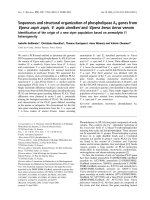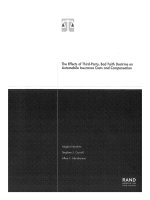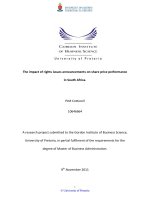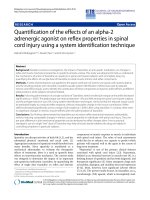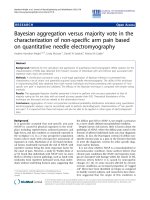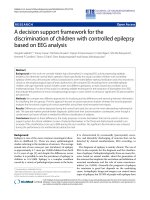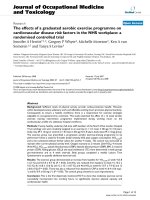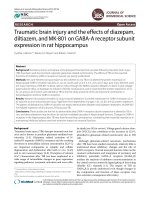the effects of teacher’s differentiated instructions based on students’ learning styles on their motivation = ảnh hưởng của việc đa dạng hóa phương pháp giảng dạy dựa trên phong cách học cá nhân đối với động lực học
Bạn đang xem bản rút gọn của tài liệu. Xem và tải ngay bản đầy đủ của tài liệu tại đây (1.61 MB, 111 trang )
VIETNAM NATIONAL UNIVERSITY,HANOI
UNIVERSITY OF LANGUAGES AND INTERNATIONAL STUDIES
DEPARTMENT OF POST-GRADUATE STUDIES
NGUYỄN THỊ THỊNH
THE EFFECTS OF TEACHER’S DIFFERENTIATED
INSTRUCTIONS BASED ON STUDENTS’
LEARNING STYLES ON THEIR MOTIVATION
Ảnh hưởng của việc đa dạng hóa phương pháp giảng dạy
dựa trên phong cách học cá nhân đối với động lực học
của sinh viên
M.A.Combined Program Thesis
Major: English Teaching Methodology
Code: 60.140.111
HANOI - 2013
VIETNAM NATIONAL UNIVERSITY,HANOI
UNIVERSITY OF LANGUAGES AND INTERNATIONAL STUDIES
DEPARTMENT OF POST-GRADUATE STUDIES
NGUYỄN THỊ THỊNH
THE EFFECTS OF TEACHER’S DIFFERENTIATED
INSTRUCTIONS BASED ON STUDENTS’
LEARNING STYLES ON THEIR MOTIVATION
Ảnh hưởng của việc đa dạng hóa phương pháp giảng dạy
dựa trên phong cách học cá nhân đối với động lực học
của sinh viên
M.A.Combined Program Thesis
Major: English Teaching Methodology
Code: 60.140.111
Supervisor: Dr. Lê Văn Canh
HANOI - 2013
i
DECLARATION
I hereby certify that this research entitled “The effects of teacher’s
differentiated instructions based on students’ learning styles on their motivation”
was conducted and then submitted in partial fulfillment of the requirements for the
degree of Master of Arts (M.A). This paper was original and has not been submitted
for any degrees at any other universities or institutions.
Hanoi, October the 11 2013
Signature
Nguyen Thi Thinh
ii
ACKNOWLEDGEMENTS
First of all, I would like to express my deepest appreciation to Dr. Le Van
Canh for his expert guidance and priceless encouragement during my completion of
this MA thesis. Reviewing the first manuscript in spite of his hectic schedule, he
made some important suggestions which greatly contributed to the final
improvements.
Special thanks should also be sent to my students at University of Languages
and International Studies, without whom the data procedures could not have ever
been completed.
Finally, I take this opportunity to record my sincere gratitude to my family,
for their patience, support and encouragement. I am also profoundly indebted to my
fiancé, Dang Tuan Thanh, for his remarkable tolerance and unshakeable faith which
motivated me enough to accomplish this paper on schedule.
iii
ABSTRACT
Motivation which has a profound impact on students‟ academic achievement
at university is determined by a lot of factors. Among them, students‟ learning style
is one of the most important one. The correlation between motivation and learning
styles has been documented in a lot of research.
This paper reports an action research undertaken in a reading course for
second-year English majors in a university in Hanoi, Vietnam. Involving a group of
twenty-six sophomores from the same class, this study aims to 1) identify the given
class‟s learning styles and current level of academic motivation; 2) project and
implement some instructional differentiations upon the students‟ different learning
modalities aiming to improve their academic motivation; and 3) evaluate the impact
of the psycho-pedagogical intervention on the students‟ motivation level. Using two
questionnaires, interviews with students, and researcher‟s self-observation and
reflection as the main research instruments, the study shows that these students had
low current level of motivation which was probably caused by different learning
preferences. Basing on the insight into the students‟ learning styles, differentiated
instructions were employed in hope to raise their motivation.
iv
LIST OF TABLES, FIGURES AND ABBREVIATIONS
List of tables
Table 1. Kolb‟s model of learning styles 12
Table 2. Dunn and Dunn‟s learning style theory (VAKT) 15
Table 3. Two out of six learning styles in Reid‟s model 17
Table 4. Three classroom elements for differentiation 21
List of figures
Figure 1. Kolb‟s model of learning styles 13
Figure 2. Learning cycle and decision factors used in planning and implementing
differentiated instruction 20
Figure 3. The flow of instruction in a differentiated classroom 23
Figure 4. Low prep vs. high prep differentiation 26
Figure 5. Components of foreign language learning motivation 32
Figure 6. The rationale behind differentiated classes 35
Figure 7. Range of activities in a differentiated classroom 39
Figure 8. The proportions of the students by their study record in the first year 45
Figure 9. Equivalent scales of 12 mini-AMTB items 51
Figure 10. AMTB questionnaire keys 53
Figure 11. The research first cycle 56
Figure 12. Students‟ perceptual learning style preferences 59
v
Figure 13. The participants‟ level of motivation before the intervention 62
Figure 14. Motivational intensity over a six-week period (Sept to Oct 2012) 70
Figure 15. English teacher evaluation over a six-week period (Sept to Oct 2012) . 72
Figure 16. Desire to learning English over a six-week period (Sept to Oct 2012) 75
List of abbreviations
AMTB: Attitude motivation battery test
PLSPQ: Perceptual learning style preference questionnaire
LS: Learning style(s)
LSI: Learning style inventory
ESL: English as a second language
EFL: English as a foreign language
vi
TABLE OF CONTENTS
DECLARATION i
ACKNOWLEDGEMENTS ii
ABSTRACT iii
LIST OF TABLES, FIGURES AND ABBREVIATIONS iv
TABLE OF CONTENTS vi
CHAPTER 1: INTRODUCTION 1
1. Statement of the problem 1
2. Aims, objectives and research questions of the research 3
3. Significance of the research 4
4. Scope of the research 5
5. Organization of the research 6
CHAPTER 2: LITERATURE REVIEW8
1. Key concepts 8
1.1. Learning styles 8
1.2. Differentiated instruction 19
1.3. Learning motivation in ESL/EFL context 28
2. Related studies 32
2.1. Evidence of effectiveness of differentiated instruction 32
2.2. Differentiated instruction and learning style 36
vii
2.3. Differentiated instruction and ESL/EFL motivation 39
CHAPTER 3: METHODOLOGY 41
1. Participants 41
2. Class problem from the teacher‟s perspective 44
3. Action research 46
4. Research instruments 48
5. Procedure of data collection 54
6. Procedure of data analysis 57
CHAPTER 4: RESULTS AND DISCUSSION 58
1. Research question 1 58
2. Research question 2 63
3. Research question 3 69
CHAPTER 5: CONCLUSIONS 77
1. Summary of the major findings of the research 77
2. The teacher-researcher‟s reflection on the project, limitations and suggestions for
next cycle 78
REFERENCES 82
APPENDICES I
1
CHAPTER 1: INTRODUCTION
This chapter containing the rationale, general objectives (guided by research
questions) and organization of the study is expected to provide readers background
materials and a map of the research paper.
1. Statement of the problem
As a lecturer in an English-major university, the researcher of this study has
been teaching several courses of English skills (listening, reading, speaking and
writing) so far. Therefore, she has had to deal with different teaching situations as
well as various kinds of English major students. Through her continuous classroom
self-observation, informal interviews with students and evaluation of students‟
lesson journals (a learning dairy which students were personally asked to keep
writing from the beginning of each course to reflect their perspectives and feelings
of the lessons and teachers), the researcher has recently identified some
questionable problems in her reading class: 1) the students were not motivated
enough to actively join in class activities; 2) some students were somehow more
involved in certain activities while sometimes the others even showed no interest in
these ones at all. Different activities may evoke different reactions and feelings
from different students. These concerned the researcher so seriously that she
decided to investigate the situation to look for the answers in a structured manner,
rather than in an informal one like before.
Reviewing the body of knowledge which is expected to probably result in the
current problem, the researcher has found some factors having a considerable
influence on students‟ motivation such as their beliefs, affective state, aptitude,
personality, age, and learning styles (To and Nguyen, 2009). Although these
elements all affect students, and thereby worth studying, the researcher intend to
keep focus only on learning style factor in relation to motivation due to her interest
and the obvious disadvantages of researching many conditions at the same time.
2
Owing to the development of brain and psychology research into individual
differences, the field of learning style theory has drawn much attention from
educational researchers since the 1970s. However, it was not until the 1980s with
the decline of behaviorism (stimulus/ response model), the concept of individual
learning preferences was taken into serious consideration in some studies as a basic
influential factor to students‟ learning. Some studies at that time could be
mentioned, for example, Cafferty‟s study of the match in teacher‟s and student‟s
cognitive style (1980), Dunn‟s work on students‟ identifying their own learning
style (1983), or learning strategies developed from learning styles differences
(Willing, 1984, 1985, 1989, 1988). These studies have come to some important
findings 1) learners have different preferred learning styles which determine their
reactions and attitudes towards particular types of in-class activities and 2) teachers‟
accommodation to different learning styles can have impact on students‟ motivation
(Hunt, 1979, quoted in Willing, 1988, 1988, p.57).
Because learning style is an influential factor on motivation, teacher‟s
accommodation to students‟ different learning mode appears to probably raise the
level of motivation. Many researchers have been arguing about
matching/mismatching theories which suggest teachers should either try to match
their teaching styles to students‟ learning styles or try to expand their comfort zone
by forcing them to study with different learning styles. Acknowledging almost all
the existing theories, differentiated instruction approach recently has gained much
attention in educational settings. According to Tomlinson (2001), the goal of the
approach is to encourage teachers to proactively prepare and offer a wide range of
activities which can cater for students‟ differences (including learning styles).
Despite a lack of numerous empirical studies over the effectiveness of differentiated
instructions, positive feedbacks from teachers during the application of the approach
in a variety of school settings have been reported worldwide.
3
For the aforementioned reasons, the researcher decided to start an action
research project named “The effects of teacher’s differentiated instructions
based on students’ learning styles on their motivation: An action research” to
find the solutions to the classroom problem. Though solutions suggested by other
researchers‟ studies may have been proved to be effective, they may never work for
her generally unique circumstance. Action research has been employed for its
practical goal of solving problem, rather than other kind of research for theory
construction or testing. This study, after finished, is supposed to contribute to a
relatively neglected area of research in Vietnam or may be implemented by other
practitioners for their shared classroom problem.
2. Aims, objectives and research questions of the research
a. Aims and objectives of the research
This study is supposed to examine the relationship among three concepts
learning styles, differentiated instructions and academic motivation in higher
education classroom setting. This action research project was conducted to aim at
solving the problem of low motivation level which possibly caused students‟ low
achievement at university.
In the light of that general aim, some specific objectives are drawn up to outline
the actual directions of the study as follows:
1) To identify the given class‟s learning styles and current level of academic
motivation;
2) To project and implement some instructional differentiations upon the
students‟ different learning modalities aiming to improve their academic
motivation;
3) To evaluate the impact of the psycho-pedagogical intervention on the
students‟ motivation level.
4
b. Research questions
In brief, the objectives of the research could be specified into these research
questions:
1) What are the students‟ learning styles and their current level of motivation?
(Identifying the problem)
2) To what extent does the new intervention cater for the students‟ learning
styles?
3) How does differentiated instruction approach affect the students‟ motivation
level in terms of their motivational intensity, lecturer evaluation and English
learning desire?
3. Significance of the research
Once having been finished, this action research is expected to find the
solutions to the problem of the researcher‟s own class; otherwise, its findings would
shed light on necessary further studies in order to solve the issue of students‟ lack of
motivation in learning English as a foreign language. In case the intervention of
differentiated instructions works for this class, it may suggest a good potential
treatment to the problem of students‟ low motivation. It does not only help the
researcher herself to overcome the difficulty in teaching but it can also be regarded
as a possible suggestion to other teachers who encounter classes of demotivated
students. In addition, this research with its thorough literature review and reliable
research instruments could function as a basic reference on the subject matter.
Therefore, it may benefit other researchers or teacher practitioners on their way to
gain a deep insight into the issue of learning styles, differentiated instructions and
motivation.
Besides, another simultaneous consequence of this action research is to raise
students‟ awareness of their learning style differences. Many students hardly
5
understand their learning styles. In fact, students are likely to admire advanced
classmates, so they tend to imitate their learning styles or methods in the hope that
they can improve their study results. This impulsive thought might then result in the
students‟ failure because of the incompatibility of applied learning styles and their
major ones. Consequently, this unsuccessful attempt usually leads to their lack of
confidence and motivation. In this study, after learning style and motivation surveys
were administered and analyzed, the results would be delivered to the students for
their own sake. Furthermore, if the researcher‟s hypothesis about differentiated
instructions by learning styles was right, students‟ motivation would be increased
significantly.
Last but not least, due to the limitation of a single action research of the
generalization to the whole population, this paper might not add much value to the
body of the existing literature as well as not persuasive enough for policy makers
and school administrators to change the methodology or syllabus. However, if more
action research like this one was conducted and the findings were confirmed,
everything would change for good.
4. Scope of the research
Action research can be done by a teacher trying to solve a single problem in
his/her classroom. Individual action research may search for solutions to the
problems of “classroom management, instructional strategies, use of materials, or
student learning” (Ferrance, 2000, p. 3). Besides, as few as two or a group of
teachers can work collaboratively on the same subject matter that is shared among
classrooms, without or with the support from principals or educational authorities.
In addition, to increase the scope of possible impacts, the other two are school-wide
and district-wide action research. All four types are likely to be differentiated in
terms of focus, possible support, potential impact and side effects.
6
According to Elliott (1991, cited in Water-Adams, 2006), the “best” (the most
emancipatory) action research is collaborative in the nature of practice, involving a
few practitioners “exploring and challenging the constraints of their professional
lives”. Meanwhile, individual one is usually criticized for lacking validity,
generalization and replication.
However, Ferrance in her booklet of the Brown university series “Themes in
Education” claimed that each type of action research has its own possible impacts
and side effects. In order to avoid disagreements on process which may cause the
delay or even failure of the research and due to the piloting nature of this study, the
researcher of this study decided to carry out an individual action research to deal
with the problems of her own classroom before suggesting it to other teachers who
share the same problem (collaborative) and then proposing it to the faculty
administrators (school-wide).
In addition, because this is an individual action research and the researcher also
would like to undertake a rigorous and thorough study, she only invited her own
reading class of second-year students to participate in the study. As a result, the data
collection and analysis could be done, and considered more carefully and thereby
producing more accurate findings.
5. Organization of the research
The study and findings are intended to be shown and discussed in the
following chapters:
Chapter 1: Introduction, which provides a broad view of the whole research by
presenting the current problem, mentioning aims and objectives of the
paper, and indicating the significance as well as the scope of the study
Chapter 2: Literature Review, which is supposed to provide theoretical background
on the issue of foreign language learning styles and motivation, discuss
7
the key concepts, identify the research gap and review the related studies
in the history both in Vietnam and in the world.
Chapter 3: Methodology, which informs readers of the participants, the chosen
instruments, procedures of data collection and analysis.
Chapter 4: Results and Discussion, which presents the description an interpretation
of the collected data in light of research questions.
Chapter 5: Conclusion which summarizes the major findings discovered by the
research and written up in the previous chapter (chap. 4). Moreover, it
suggests some pedagogical implication for teachers who share the same
problem as the researcher. The limitations and suggestions for future
studies are also discussed in this last chapter.
8
CHAPTER 2: LITERATURE REVIEW
This chapter was the review of the existing literature relevant to the subject matter
which was under the researcher‟s investigation. In this chapter, some key concepts
would be explained clearly and thoroughly. In addition, related research works in
both international and Vietnam context would be analyzed and synthesized to
supply readers with a broad view of the topic in the scholarly world.
1. Key Concepts
1.1. Learning styles
a. Definition of learning styles
Individual difference is not a new field of study. Before the 1970s, this term
was considered somehow synonymous with ability difference measured by standard
intelligence tests. However, owing to the achievements in psychology in the 1970s,
researchers soon realized the narrowness of this assumption. Therefore, the concept
of individual difference henceforth was changed into the differences in many
aspects such as learning styles, interests, motivations, genders or ages. Among
them, “learning styles” may have been one of the most popular parts which have
been studied since it was first used in the 1970s. The studies on learning styles have
been continuing for roughly five decades.
Although it would be not conclusive enough to prove the emergence, recent
years witnessed the dramatically increasing records of the researcher numbers
working in this area. Apart from psychological field, research into learning styles
has also been conducted in a vast variety of domains, including management,
vocational training and especially education in different settings and levels.
Since a vast quantity of research and practitioner-based studies have
deliberately targeted at learning style, there are now a wide range of definitions,
theoretical positions, models, interpretations and measures of the construct in the
9
area (Cassidy, 2004). On the one hand, this can be convincing proof of the
prevalence of this theory in education and it provides the interested investigators
with useful extensive literature for gaining thorough understanding of the issue. On
the other hand, this fact also causes the researchers such a lot of trouble when it
comes to the matter of ambiguity, conflicting outcomes or measuring instrument
selection.
For those who are novices at the subject matter, it is quite confusing when
they encounter the terms “learning styles”, “cognitive styles” and “learning
strategies”. To some extent, these concepts are usually used interchangeably in the
learning style-related research with little difference in meaning. However, in some
cases (for some special purposes), these terms need to be clearly distinguished.
According to Allport (1937, in Cassidy, 2004) and Riding & Cheema (1991, in
Cassidy, 2004), an individual‟s learning style is the application of his cognitive
style into learning situation. In other words, in education cognitive style is an
important component of learning style. Meanwhile, “learning strategy” and
“learning style” share a lot in common, except that the latter is adapted more
automatically to handle different learning tasks.
When it comes to the idea of learning styles, people must bear in mind a
simple but reasonable assumption put forward by Dunn and Dunn (1983) “everyone
has strengths, but different people have very different strengths”.
Since the term “learning style” was first in use in the 1970s, there have been
tireless efforts among scholars and researchers to define it. Therefore, it is not a
great surprise to find numerous definitions of learning styles.
Among these countless trees, there is one oak which should not and cannot
be ignored. The definition by Keefe (1979) has been mentioned in lots of learning
style research (Reid, 1987; Willing, 1988; Coffield, 2004).
10
Learning styles are characteristic cognitive, affective, and physiological
behaviors that serve as relatively stable indicators of how learners perceive,
interact with, and respond to the learning environment … learning style is a
consistent way of functioning, that reflects the underlying causes of learning
behaviors. (p. 40)
Three components of learning styles referred to in the definition could be
presented as follows:
Perceptual
The sensory channels (one or more senses) individuals rely on
to perceive, understand, organize and retain knowledge (Dunn
and Dunn, 1979; R. Dunn, 1983; Reid, 1987)
Physiology
Primary importance in shaping the way information is sought,
and the way it is processed (Swassing, 1979)
Determine the state of the entire organism, the senses and the
nervous system (Dunn and Dunn, 1979a)
Affective
Affective factors (i.e. anxiety) influencing the person‟s level of
achievement (Naiman et al. 1975)
(Willing, 1988, pp. 52-55)
The Keefe‟s idea of these components were shared by Dunn, Dunn and Price
(1978, acknowledged in Willing, 1988, p. 56) and even specified more into 18
identified learning style elements.
For the consistency of the study, whenever the term learning style is
mentioned, it refers to the notion by Keefe (1979). Moreover, it is worth noting
clearly at this point that this study just focus on sensory channels or perceptual
learning preferences as a primary part of learning style differences.
11
b. Learning style theories, models and measures
As mentioned earlier, this study field of learning style has drawn much
attention from plenty of researchers around the world. Consequently, this following
review of learning style models and instruments would be impossible to be all-
inclusive. Rather, it is going to refer to the most reviewed constructs in significant
review papers and excludes the minor models that are only the adaptation of the
critical models to small-scale samples or just the new labels of the existing
constructs.
In the review entitled “Learning Styles and Pedagogy in Post-16 learning” by
Coffield et al. (2004), 71 learning models which had been developed for the last 40-
50 years were listed. Among them, the reviewers identified 13 major models mostly
basing on their popularity.
Therefore, in this paper the researcher would not mention these minor ones.
Out of the 13 leading models, David Kolb‟s Learning Style Inventory (LSI) and
Dunn, Dunn and Price‟s LSI are the most well-known and widely used in the UK
and US respectively. Moreover, Joy Reid‟s (1987) model was also reviewed on this
part because of the researcher‟s later use of his self-report questionnaire.
David Kolb’s learning styles model
David Kolb (1984) defined learning style as “individual orientations that
gave differential emphasis to the four basic learning theory: Concrete Experience
(CE), Reflective Observation (RO), Abstract Conceptualization (AC) and Active
Experimentation (AE)”. These four were grouped into two categories: experience-
grasping approach with CE and AC; and experience-transforming approach with
RO and AE. Depending on the dominance of one experience-grasping and one
experience-transforming among four factors inside an individual, there were four
basic types of learning styles as follows:
12
Learning style
Dominant factors
Characteristic features
Converger
AC (thinking) and AE
(doing)
Practical applications of ideas
and deductive reasoning
Diverger
CE (feeling) and RO
(watching)
Imaginative and good at
coming up with ideas
Seeing things from different
perspectives
Assimilator
AC (thinking) and RO
(watching)
Capable of creating theoretical
model with inductive
reasoning
Accommodator
CE (feeling) and AE
(doing)
Actively engaging with the
world and actually doing
things instead of merely
reading about or studying
them
Table 1. Kolb’s model of learning styles
13
Figure 1. Kolb’s model of learning styles
Dunn and Dunn’s VAK/ VAKT models
Rita Dunn and Kenneth Dunn have spent more than 35 years devoting on the
studies concerning the learning styles (identification, instruments and assessment of
learning styles, etc.).
As mentioned before, Dunn, Dunn and Price (1978, cited in Willing, 1988)
included perceptual strengths in the 18 distinguishable learning style elements. The
perceptual strength element consisted of three types of learning preferences in
receiving the knowledge inputs: visual (prefer viewing pictures, maps, diagrams,
etc.), auditory (favor listening to tapes, lectures or music), and kinesthetic (involve
more in doing, touching and moving). Thus, the Dunns‟ learning style model is
frequently used in American school system known as VAK or sometimes VAKT
with tactile (prefer hands-on involvement, note taking, model building, etc.)
included (Coffield et al., 2004).
14
According to the Dunns‟ theory, each individual have one or two dominant
styles (among those basics) which will role as the filter to favorably receive the
information delivered in the individual‟s best way of learning.
Dominant
learning style
Description/ characteristics
V: visual
- Mind sometimes strays during verbal activities
- Observes, rather than talks or acts; may be quiet by nature
- Organized in approach to tasks
- Likes to read
- Usually a good speller
- Memorizes by creating mental images
- Thinks in pictures
- Easily put off by visual distractions
- May focus on the „big picture‟ and use advanced planning
- Finds verbal instructions difficult
- Remember faces
- Strong on first impressions
- May have good handwriting
- Enjoys using color
- Notices details
- Often a quick thinker
A: auditory
- Talks to self aloud
- Outgoing by nature
- Whispers to self while reading, may hum or sing while working
- Likes to be read to
- May be particular about the exact choice of words
- Memorizes by steps in a sequence
15
- Very aware of rhythm
- Easily distracted by noises
- May have difficulty with written instructions
- Remember names
- May assess people by the sound of their voice
- Enjoys music and the sounds of words
- Enjoys talking and listening
- Can remember – and often mimic – speech by picking up rhythm
of the sentence
- May need time to think (i.e. discuss it with myself)
- May assess a situation on „how it sounds‟ to them
K:
kinesthetic
- In motion most of the time/ fidgety
- Outgoing by nature; expresses emotions by physical means
- Reading is not a priority
- May find spelling difficult
- Likes to solve problems by physically working through them
- Very good body control, good timing and reflexes
- May need time to think (i.e. process the actions involved)
- Will try new things – likes to get involved
- Like physical rewards
- Remembers what they have done rather than seen/ heard
- May assess people and situation by what “feels right”
- Enjoys doing activities
- Plays games, simulations and role-playing
- Prefers experiments
- Favors dance-related activities such as folk dances, singing,
rhythmic movements, creative dance
T: tactile
- Uses their hands, likes to use gestures and touch people while
talking to them
16
- Underlines
- Takes note
- Constructs models
- Loves art-related activities such as drawing, painting, and
sculpting
- Makes diagrams, mind maps, webs
- Taps pencil or foot/ fiddles with objects while studying
Table 2. Dunn and Dunn’s learning style theory (VAKT)
(Source: Authors; Adapted from Coffield et al., 2004; Dunn & Griggs, 2003; Dunn,
2001; Dunn, 2003, cited in Penger & Tekavcic, 2009, p. 6)
Joy Reid’s VAKT model
Joy Reid was one of the well-known researchers who had spent quite a lot of
time and effort studying learning styles, especially perceptual strengths.
Once realizing that no research had been published on the perceptual
learning styles of non-native speakers (NNSs) of English before and then claiming
that failure may rest not only on material but teachers‟ unawareness of learning
styles as well, Reid (1987) on TESOL Quarterly reported his study which provided
the insights into NNSs‟ perceptual modalities in their classroom.
Like Dunn and Dunn, Reid also followed VAK/VAKT model which was
added two more components named group and individual learning styles. Hence,
Reid‟s consisted of 6 learning styles instead of 3 or 4 constructs as usual.
Referring back to Dunn and Dunn‟s definition of learning style, these two
constructs could somehow be found in the sociological element (working alone, in
pair, with peers, in team, with adults, or varied). Meanwhile, they were included in
